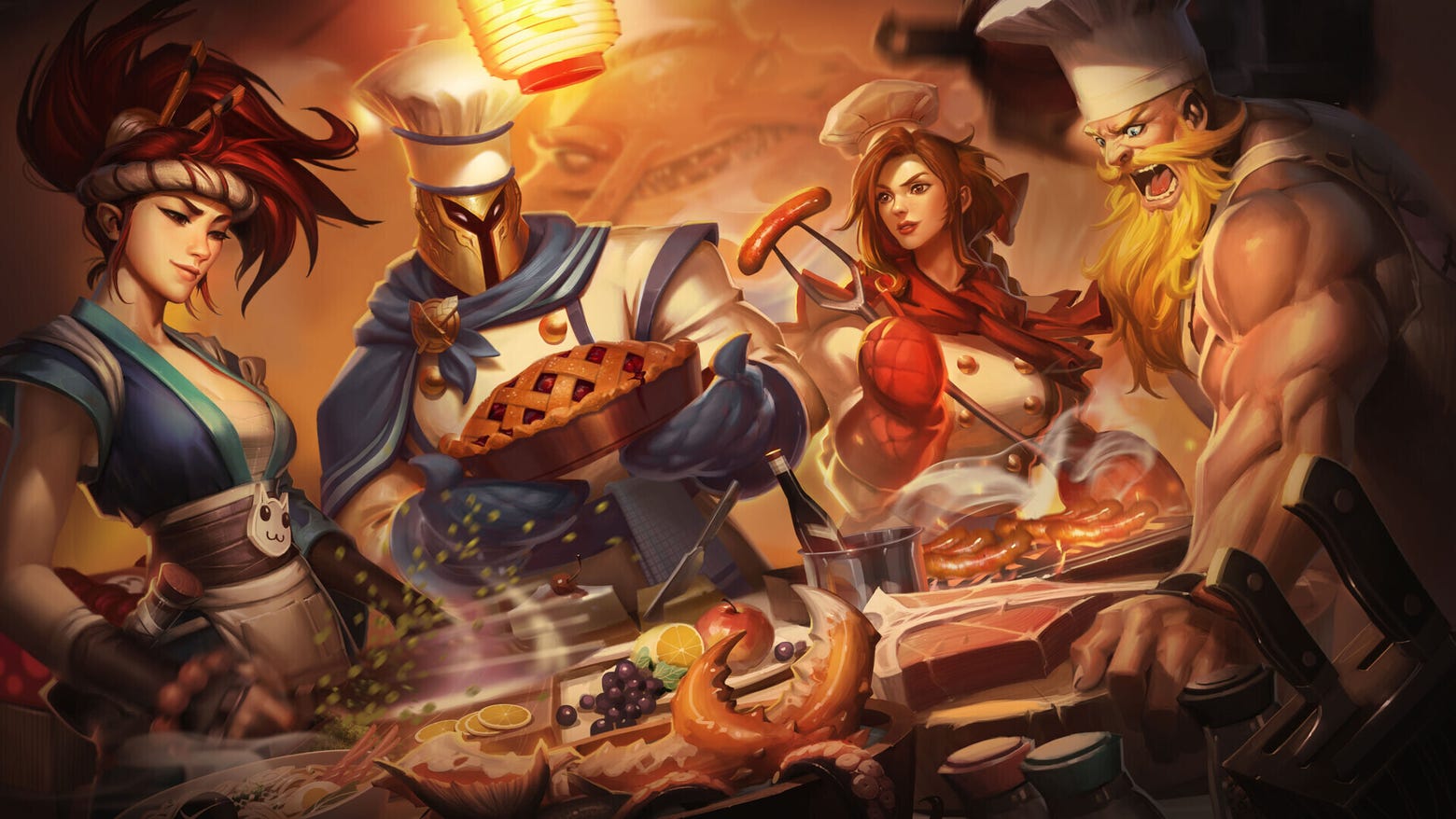Welcome back to Quick Gameplay Thoughts! We took a short break to work on this Midseason update, but now that it's shipped we have some not-so-quick thoughts about gameplay we’d like to share.
But before jumping into that, we want to acknowledge and say that we agree with feedback that top lane and Mage mid experiences aren’t great at the moment. However, we don’t believe champions buffs and items alone are sufficient as we think a lot of the problems are tied to the innate map design that were not solvable for Midseason (Mages and top laners being too gankable requires re-designing some parts of the map, among other possible tactics).
In 13.10, we buffed some Mage and Fighter itemization, nerfed some Mage item counters and shipped a small Teleport buff to address some of this weakness. We know there’s still a lot of work that can be done in this arena, and we’re continuing to think about this space in the long term and short term.
For Midseason this year, we wanted to make improvements to several item systems and game mechanics (minion rules, plants, etc.), as well as test a pilot of an alternate take on Mythic items to test some assumptions for Preseason work (see here). For this specific QGT, we'd like to talk a bit about the design insights for some of the content that shipped in patch 13.10.
Crit Item Changes
Worked on by Riot Phreak and Riot Truexy
The crit item changes started with an exploration of what the system would look like if Infinity Edge, Navori Quickblades, and Guinsoo’s Rageblade were the official Mythic items. It’s a departure from the old direction of Mythic items (create as much parity as possible and Mythics should be bought first) and onto a new direction that focuses on Mythics being your most impactful item, even if that means your favorite champion is hard-bound to just one of them.
From there, it was figuring out if a new Mythic should enter the fold and what the former Mythics should look like. We spent some time prototyping Statikk Shiv as a Mythic whose bounces scaled with Mythic passive and carried all other Energize effects on its chain lightning, but we decided against making a mythic with such rigid synergies. In the end we decided to retain Galeforce as a Mythic since that was the only way to keep Galeforce’s active effect.
Demoting the former mythic items to Legendary was just a matter of trimming down their stat profiles (since they no longer had to be generically usable) and pulling their gold efficiency down to the level of Legendary items. We decided to keep Noonquiver as an early stepping stone Epic item and used it to ensure likely first-item purchases for crit champions had smooth build paths.
The goal with the other Legendary item shifts was bringing their prices closer together to facilitate direct comparisons while also shipping small buffs to underused items and nerfs to overused ones. The same tuning logic went into epic items to ensure none of the components ended up being bait.
Early data on 13.10 has shown some balance outliers, which we’re adjusting in 13.11. We will continue to tune the system to ensure that each item is best in slot somewhere, and we’ll continue to monitor role power over time as well.
Assassin Changes
Worked on by Riot Truexy
Assassins have been in a rough spot since the 12.10 Durability Patch. We knew the class was weak, but ran into the same problems that have slowed us down since Season 10…the Mythics. The Assassin Mythics came with some of the most exciting and unique effects, but were also some of the most dangerous to game health. This meant that we kept the Assassin items at a lower winrate than a lot of other classes. Whenever the class was up for buffs, we were left with buffing the items that we knew would be risky to the game when powerful (Duskblade and Prowler’s Claw) or buff the champions, knowing that if we ever adjusted their items that we’d quickly need to undo a lot of those cool, champion specific, buffs.
We decided to adjust the Assassin Mythics to have less power in their frustrating effects (dashes, repeated stealth) so that we could shift more into power that Assassin players needed. This gave us the room to expand upon each Assassin’s needs and let them pick which items fit their perfect lethal fantasy.
In Season 10, we originally wanted Ghostblade as an Assassin Mythic, but held it back since we thought the effect was a bit too generic and didn’t fit the goal of “game-to-game decisions” that we originally wanted for the system. We’ve since loosened that restriction and want to return an item that Assassin players have been building first for ages. We have added some nuance as the item has been reshaped to be all about shifting around the map for one upfront burst moment.
Duskblade has been changed to be our other standard Assassin Mythic, and has a focus on seeking out low health enemies and executing them for a quick getaway. We’ve shifted away from Stealth, which was a big clarity hit to enemies, and altered it to a more understandable (and a bit weaker) version of Untargetability. With less power centered in a stretch fantasy of four Stealth resets, Duskblade can have the power budget to better help Assassins pick off those weak stragglers.
We’ve left Eclipse the same as it’s a fantastic bridge between a more greedy Fighter DPS pattern and burst Lethality. All in all, we hope the new structure of roaming burst damage, low health pickoff, and repeated DPS better helps the entire Assassin class at completing their one true dream…..killing that pesky Marksman.
Support Item Changes
Worked on by Riot Bokurp and Riot scaz
The Support item explorations started with the goal of trying to see if we can enable Supports to make more item choices over the course of the game. Because Supports generally have less access to gold, they typically don’t get to build many items compared to other roles. Also, some of the items they do build just don’t really feel that satisfying or noticeable even if they are effective. So we wanted to evaluate the Support item ecosystem as a whole, and then see what improvements we could make in time for Midseason.
The general strategy here was:
- Lower completed item gold costs so Supports can build more items in an average game
- Look for opportunities to position some items as Support options (Abyssal Mask, Radiant Virtue)
- Create a late-game gold sink/capstone item for those games where you get really ahead and have a full inventory (Vigilant Wardstone)
- Smooth out the build paths to completed items by adding new components (Chalice of Blessing and Lifewell Pendant) and tweaking some item recipes
- Put more power into passives where we can so they’re more noticeable and fulfilling their need (Ardent Censer, Staff of Flowing Water)
- Find an opportunity in the system for a big satisfaction win
That last point led to us looking at the Enchanter Mythic system. Shurelya’s Battlesong was operating as a catch-all, satisfying Mythic that most Support Enchanters used by default, Imperial Mandate was rarely being bought outside of Nami/Ashe, and Moonstone Renewer was powerful and intellectually satisfying, but difficult for the user to feel over the course of a fight.
We liked the general framework of having one defensive Enchanter Mythic, one that provides utility, and one that is offensive, but we wanted to explore ways to make the effects feel more tangible to Enchanter players.
We experimented with an Enchanter Energized model, where you would gain stacks by moving/healing/shielding. Then at 100 stacks, your next heal/shield would supercharge your ally’s next attack with a ton of damage or supercharge your heals for the rest of combat. Ultimately these models missed the mark because the cool part of Energize is the build up to making your next action special, but healing/shielding is usually a reaction to enemies trying to kill your teammate. Having these lineup to create a cool moment was too infrequent to be satisfying and felt bad when it was wasted.
After a bunch of explorations, we ended up with a model where the Enchanter Mythics transform your heals/shields in some way. Echoes of Helia turns your heals/shields into healing and damage as an offensive skirmishing option. Shurelya’s Battlesong keeps its role by providing movement speed utility and still has a powerful Active. Moonstone Renewer is the primary defensive option that chains your heals/shields to additional targets and is especially strong with AOE in teamfights. By tying the items closer to the action of healing/shielding, we hope you can feel their impact more.
Longer term, we will keep an eye on these changes to see if satisfaction has gone up and will adjust as necessary. We also know that there are other parts of the Support ecosystem (like some of the Support Tank items) that we didn’t get to address this time around for increasing satisfaction, but we hope to get to them at some point.
Early Game Changes
Worked on by Riot Truexy
As League has evolved, laning phase has become more and more about finding an advantage in order to roam to other lanes rather than kill your direct lane opponent. While one of the high points is skill diffing the enemy laner, it’s become more and more common that the best play is to go influence another lane. Similarly, the windows of having a “fair and honorable 1v1” are few and far between, with ganks and roams interrupting the laning phase extremely frequently.
Our goal for Midseason was to emphasize the laning phase, which means:
- Increase the amount of times you can 1v1 or 2v2 your lane opponent
- Reduce the very early influence of other lanes/ganks on your lane’s success
- Support smaller early losses so that 1 lost trade doesn’t end the laning phase
In the upcoming patch, it will be harder to take multiple tower plates in a single push (especially when ganked), you’ll be able to use one ward to cover more gank paths, and you’ll be a bit more resilient to tower dives.
The largest change of the patch will be syncing when the minion waves meet between lanes. Previously, the mid lane minions would meet well before the side lane ones would. This desync would mean each lane would have the time to quickly clear their wave and leave vision to look for a gank. If the enemy laner extended themself to farm the wave or was weak to a dive, the player would complete the roam, if not then they could return to their lane and miss almost no minion experience or gold. Syncing the waves increases the opportunity cost of roaming and should give attentive laners a bit more leeway when risking themselves to push or farm a wave.
Long term, we’ll monitor how these changes affect all levels of play and adjust accordingly. We don’t want to remove roaming and playmaking as it’s an integral part of why League is fun and why there’s a risk to pick weaker, scaling champions. We hope these changes even out the balance between laning and roaming, so that there’s more outplay moments and bit less “jg/mid/support roaming diff”.
And that’s it for this week’s non-so-quick gameplay thoughts. As always, thanks for reading and see you on the Rift!

